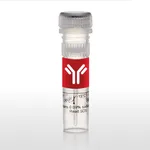
Thermo Fisher Scientific Ephrin B3 Polyclonal Antibody
✨AI 추천 연관 상품
AI가 분석한 이 상품과 연관된 추천 상품들을 확인해보세요
연관 상품을 찾고 있습니다...
Applications
Tested Dilution
Publications
Western Blot (WB)
1:1,000
Immunohistochemistry (Paraffin) (IHC (P))
1:50-1:200
Immunocytochemistry (ICC/IF)
1:100-1:500
Product Specifications
Species Reactivity
Human
Host/Isotype
Rabbit / IgG
Class
Polyclonal
Type
Antibody
Immunogen
A synthesized peptide derived from human EFNB3(Accession Q15768), corresponding to amino acid residues A231-G281. if (typeof window.$mangular === undefined || !window.$mangular) { window.$mangular = {}; } $mangular.antigenJson = \[{targetFamily:Ephrin B3,uniProtId:Q15768-1,ncbiNodeId:9606,antigenRange:231-281,antigenLength:340,antigenImageFileName:PA5-99619_Ephrin_B3_Q15768-1_Rabbit.svg,antigenImageFileNamePDP:PA5-99619_Ephrin_B3_Q15768-1_Rabbit_PDP.jpeg,sortOrder:1}\]; $mangular.isB2BCMGT = false; $mangular.isEpitopesModalImageMultiSizeEnabled = true;
View immunogen .st0{fill:#FFFFFF;} .st1{fill:#1E8AE7;}
Conjugate
Unconjugated Unconjugated Unconjugated
Form
Liquid
Concentration
1 mg/mL
Purification
Affinity chromatography
Storage buffer
PBS, pH 7.4, with 50% glycerol
Contains
0.02% sodium azide
Storage conditions
-20°C
Shipping conditions
Wet ice
RRID
AB_2818552
Product Specific Information
Antibody detects endogenous levels of total Ephrin-B3.
Target Information
EFNB3, a member of the ephrin gene family, is important in brain development as well as in its maintenance. Moreover, since levels of EFNB3 expression were particularly high in several forebrain subregions compared to other brain subregions, it may play a pivotal role in forebrain function. The EPH and EPH-related receptors comprise the largest subfamily of receptor protein-tyrosine kinases and have been implicated in mediating developmental events, particularly in the nervous system. EPH Receptors typically have a single kinase domain and an extracellular region containing a Cys-rich domain and 2 fibronectin type III repeats. The ephrin ligands and receptors have been named by the Eph Nomenclature Committee (1997). Based on their structures and sequence relationships, ephrins are divided into the ephrin-A (EFNA) class, which are anchored to the membrane by a glycosylphosphatidylinositol linkage, and the ephrin-B (EFNB) class, which are transmembrane proteins. The Eph family of receptors are similarly divided into 2 groups based on the similarity of their extracellular domain sequences and their affinities for binding ephrin-A and ephrin-B ligands.
For Research Use Only. Not for use in diagnostic procedures. Not for resale without express authorization.
🏷️Thermo Fisher Scientific 상품 둘러보기
동일 브랜드의 다른 상품들을 확인해보세요

Thermo Fisher Scientific
Thermo Fisher Scientific ELTD1 Polyclonal Antibody
764,500원

Thermo Fisher Scientific
Thermo Fisher Scientific GSPT1 Polyclonal Antibody
680,400원

Thermo Fisher Scientific
Thermo Fisher Scientific Ephrin B3 Polyclonal Antibody
720,500원

Thermo Fisher Scientific
Thermo Fisher Scientific EPS8L3 Polyclonal Antibody
764,500원

Thermo Fisher Scientific
Thermo Fisher Scientific CYP4F2 Polyclonal Antibody
764,500원
배송/결제/교환/반품 안내
배송 정보
| 기본 배송비 |
| 교환/반품 배송비 |
|
|---|---|---|---|
| 착불 배송비 |
| ||
| 교환/반품 배송비 |
| ||
결제 및 환불 안내
| 결제수단 |
|
|---|---|
| 취소 |
|
| 반품 |
|
| 환급 |
|
교환 및 반품 접수
| 교환 및 반품 접수 기한 |
|
|---|---|
| 교환 및 반품 접수가 가능한 경우 |
|
| 교환 및 반품 접수가 불가능한 경우 |
|
교환 및 반품 신청
| 교환 절차 |
|
|---|---|
| 반품 절차 |
|
